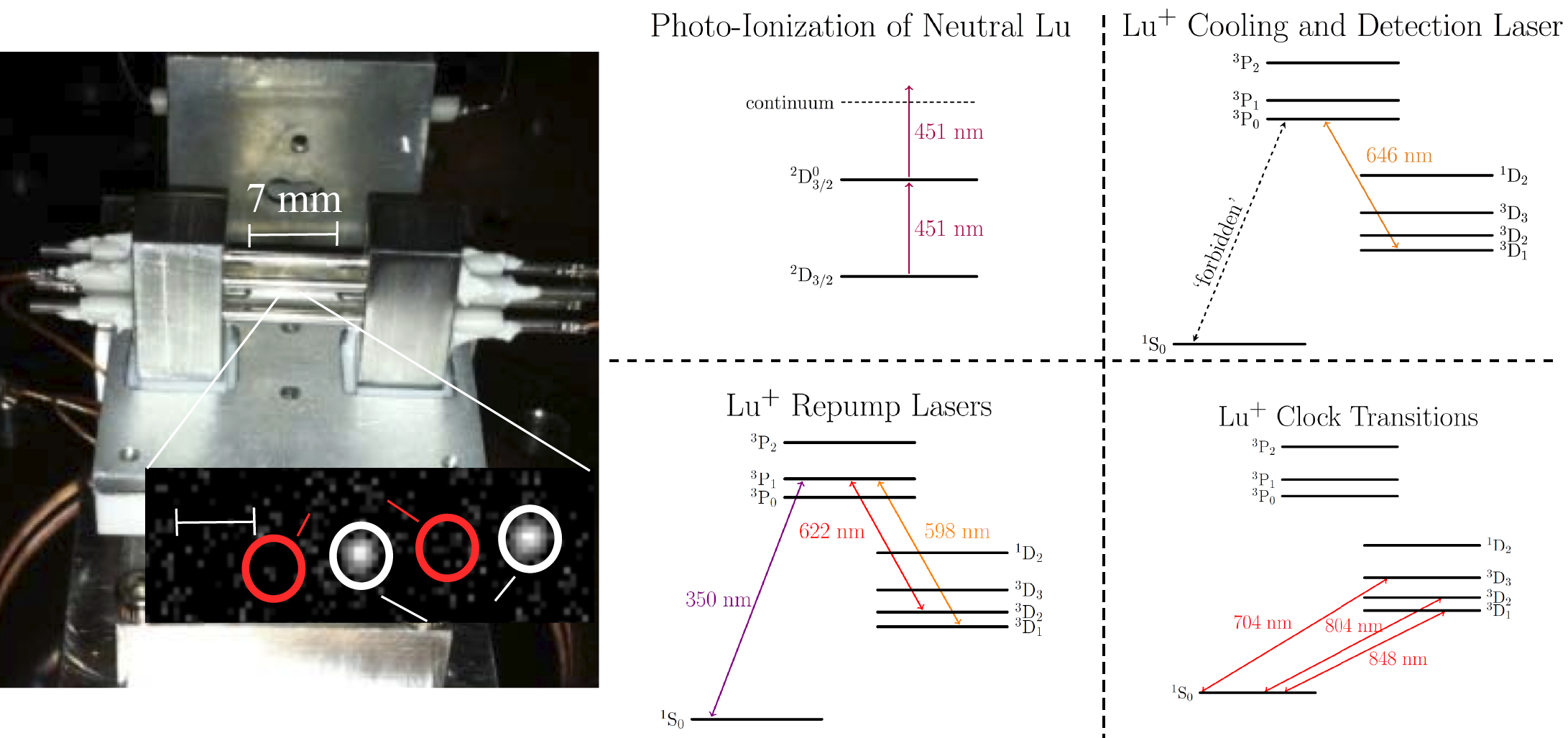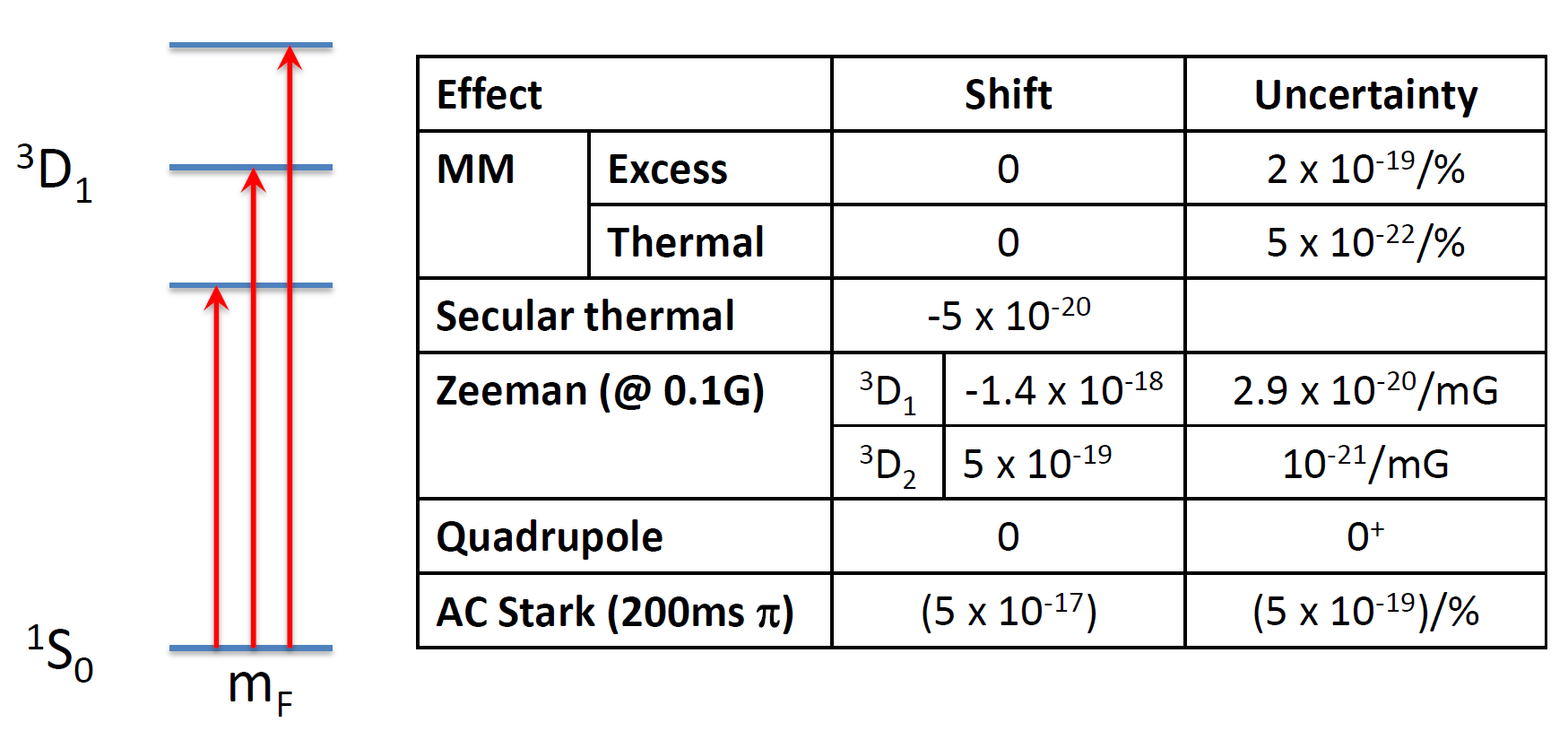Lutetium Clock Experiment
Lutetium ions (Lu+) have two valence electrons, which provide an atomic structure similar to neutral Barium. The metastable D states are long lived with the 3D1 state having an estimated lifetime of ~23 hours. This gives the 1S0 to 3D1 transition at 848 nm an estimated Q of ~ 2.4 x 1020. Our goal is to utilize this transition for an optical atomic clock. We are currently improving our control in the manipulation of Lu+ ions and performing measurements of the atomic structure to evaluate its suitability for precision metrology.

Trapping and Cooling
Lutetium has two stable isotopes, 175Lu and 176Lu, with nuclear spins I=7/2 and I=7 respectively with 175Lu having a natural abundance of 97.5%. Ions are formed by photoionization, which is conveniently achieved via two-photon absorption from a single laser as illustrated in the figure. Detection of the ion is achieved via fluorescence from the 3D1 to 3P0 transition, which is nominally a closed transition. However hyperfine mixing gives rise to relaxation out of this detection channel. Recently we have measured the decay rate for this unwanted channel to be less than 1Hz compared to the total line-width of 2.45 MHz. Thus, under reasonable excitation conditions and modest collection optics we can easily detect the ion before an unwanted decay occurs.
Currently we use Barium ions as a means to sympathetically cool Lu+. However the linewidth of the 3D1 to 3P0 transition should provide the ability to cool the ion to very low temperature. The Doppler cooling limit is determined by the linewidth and since this linewidth is an order of magnitude lower then most other ion transitions we expect to achieve very good cooling results. We hope to demonstrate this in the near future, which will free us from the need to use Barium.
Why Lutetium?
Our choice of Lu+ as a clock candidate is based on the consideration of the most important effects limiting clock performance for ions:
For Lu+ these shifts can be made extremely small. Taking an average value over multiple transitions as indicated in the figure below, the effects of external fields large cancel. In the table we give estimates of the shifts and associated uncertainties we expect to be able to achieve.

Blackbody Radiation Shifts
The thermal electromagnetic environment couples to atom resulting in energy shifts of the levels and thus a shift in the transition frequency. The shift is proportional to the differential polarizability, Δα for the transition and the forth power of temperature. For Lu+, this leads to an estimate fractional frequency shift of 10-17 at room temperature. A temperature inaccuracy of 1 degree or 1% inaccuracy in the estimation of Δα then translates to a fractional frequency inaccuracy of 10-19.
Micromotion
In an ion trap, oscillating RF electric fields confine the ion. In ideal circumstances the ion sits at a null of the oscillating field. In the presence of a stray electric field, the ion is displaced from the null position and undergoes small rapid oscillations at the frequency of the RF field. The rapid motion of the ion gives rise to a Doppler shift of the transition frequency. In addition, the presence of the oscillating electric field also causes an AC stark shift of the atomic energy levels and thus a shift in the transition frequency. In Lu+, these two shifts have opposite sign and exactly cancel for an RF frequency near 20 MHz.
Thermal secular motion
Thermal motion at the secular frequencies also gives rise to further second order Doppler shifts. Since Lu+ has both a heavy mass, and a narrow linewidth cooling transition, this shift is expected to be very small. Assuming operation at the Doppler limit of the cooling transition we estimate a fractional shift of 5 x 10-20.
External fields
External fields, perturb the energy levels of an atom: magnetic fields couple to the atom's magnetic dipole moment, and gradient electric fields couple to the atom's quadrupole moment. We have recently shown that averaging of transitions to multiple hyperfine manifold exactly cancels these shifts leaving only a small magnetic field shift due to coupling with neighbouring fine structure levels. The large fine structure splitting in Lu+ results in a fractional frequency shift of ~ 10-18 at an operating field of 0.1G.
AC Stark Shift from the probe
Light used to drive the transition can itself induce level shifts due to off-resonant coupling to other levels. This is particularly problematic for strongly forbidden transitions as in Lu+. Insufficient information on the atomic structure makes it difficult to reasonable estimate this shift. However, as with the Yb clock transition we expect this shift to be by far the most dominant. The use of hyper-Ramsey spectroscopy should make this potentially large shift more manageable.
